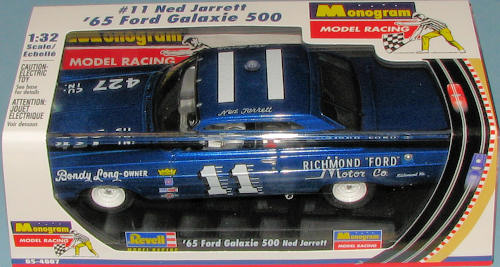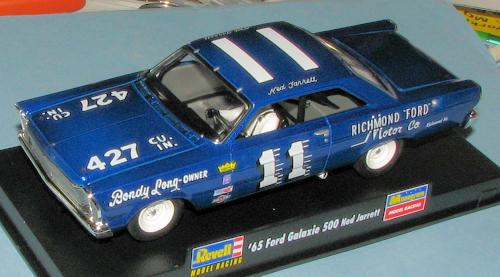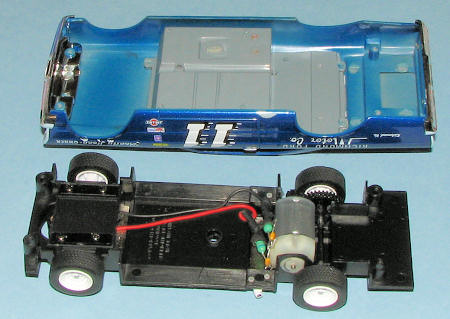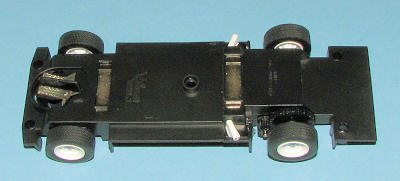
Monogram 1/32 1965 Ford Galaxie
| KIT: | Monogram 1/32 1965 Ford Galaxie |
| KIT #: | 85-4887 |
| PRICE: | $44.00 MSRP ($33.70 at GreatModels) |
| MARKINGS: | #11 Ned Jarret |
| REVIEWER: | Scott Van Aken |
| NOTES: |

| NED JARRETT |
Ned Jarrett (born October 12, 1932 in Newton, North Carolina) is a retired race car driver and two-time NASCAR champion.
Jarrett was best known for his calm demeanor, and he became known as "Gentleman Ned Jarrett". Yet he was an intense competitor when he put his two hands on the steering wheel of a NASCAR Grand National stock car. He is the father of Dale Jarrett, who only recently retired from a full career as a driver.
Jarrett was introduced to cars early in life: his father let him drive the family car to church on Sunday mornings when he was nine years old. Ned started working for his father in the sawmill by the time he was 12, but racing was what he wanted.
Ned drove in his first race in 1952 at Hickory Motor Speedway's (North Carolina) first race. He drove a Sportsman Ford that he co-owned with his brother-in-law, and finished tenth. This did not go over well with his father. His father told him he could work on cars but not drive them. Once, his brother-in-law was sick for a race and asked Ned to fill in for him. Ned used his brother-in-law's name and came in second in that race. That worked out so smoothly that Ned drove in a few more races under an assumed name, but was finally caught by his father after winning a race. His father told him if he was going to drive to at least use his own name.
Jarrett raced in his first national race at the 1953 Southern 500 at Darlington Speedway. He was out after 10 laps after the engine leaked oil.
Jarrett was the 1955 track champion at Hickory Motor Speedway.
Jarrett came in second driving in the Sportsman series (now Nationwide Series) in 1956, and won the 1957 and 1958 championships.
In 1959, he was looking to pursue a career in Grand National (now Sprint Cup) series. He purchased a Junior Johnson Ford for $2,000. He didn't have enough money to cover the check, so he waited until the bank closed to write the check, entered two races, and won them both to cover the cost of his car.
In 1960, he won five races and took the championship over Rex White in 1961. He was among the top five drivers in 22 races and missed being among the top ten drivers only 12 times out of 46 races, with one win.
One indicator of the personal character of "Gentleman Ned" Jarrett is demonstrated by the decision to sell his 1961 (raced as #11) Chevrolet to Wendell Scott (the first NASCAR African American driver) who travelled from his Virginia home to Ned's shop on West "A" Street in Newton, NC to take delivery of the '61 Chevy Bel Air (raced the previous season) when Ned changed to Fords in 1962. Wendell hauled the old blue 1961 Chevrolet Bel Air coupe away on the back of an open trailer. Bobby Isaac frequented the shop on West A Street during this period when Bud Alman was the crew chief assisted by mechanic "John Carl" Ervin. Ervin would later become Crew Chief to Ned and the #11 Fords.
Jarrett was once overheard talking with Bud Alman and John Ervin about the need to "run all the races" to win the championship. Races in those days sometimes included more than one race per week. Among the unique tracks of the early era was Bowman Grey Stadium in Winston-Salem NC which was actually the area around the football field inside the Bowman Grey Stadium. The race schedule was difficult. The race teams were smaller- often having only one or two paid members.
In order to meet the race schedule for Daytona when the new "Fastbacks" were introduced by Ford, Bud Alman and John Carl Ervin removed (air-chisled) most of the body from a 1962 Ford "fatback" dirt car. Next, the two air-chisled the new body from a '63 Fastback and fitted it onto the old body and chassis. This hybrid body went on to become the car Ned drove into the "Fastback Ford" sweep (top five positions) at Daytona that year. The Fastback bodies had arrived from Ford in wooden crates.
In 1964, Jarrett joined team owner Bondy Long and with the support of Ford won 15 times but lost the championship to Richard Petty. Jarrett picked up his first superspeedway win at Atlanta Motor Speedway.
In 1965, Jarrett became a super star when he won 13 races and another Grand National championship. He placed among the top five in 42 of the 54 races that he ran.
The 1965 Southern 500 at Darlington Raceway was one of the wildest races in NASCAR history. Rookie driver Buren Skeen died after two cars ran into the side of his car in the early laps. Sam McQuagg was leading the race, when Cale Yarborough tried to muscle past McQuagg for the lead. Yarborough flew over the guardrail, rolled around six times, and ended up at the end of the parking lot by a light post. Yarborough waved to the crowd as he walked back to the pits. A video clip of the wreck was used on ABC's Wide World of Sports for several years. With 44 laps left, Fred Lorenzen and Darel Dieringer were fighting for the lead far ahead of Jarrett. Lorenzen's motor expired, and even before he could get into the pits Dieringer's motor started smoking too. Dieringer continued at a slower pace to finish third. The race was won by Ned Jarrett by 14 laps, which is the largest margin of victory in NASCAR history.
In 1966, Jarrett was in the run for another championship when Ford announced that they were withdrawing from NASCAR. With that, Jarrett decided that it was time to retire at the young age of 34. Jarrett is the only driver to retire as the NASCAR champion. Many of us have known Ned Jarrett through his co-anchor of NASCAR racing broadcasts on CBS.
| THE CAR |
 This is a new slot car from Revell using the Monogram label to
promote its series of early/mid 1960s NASCAR racers. Though Revell is a stronger
name in Europe, in the US, it was Monogram that many of us baby boomers turned
to when we bought our first slot car set. It really is just marketing as all of
the various cars by both Revell and Mongram are built in a factory in Shanghai.
This is a new slot car from Revell using the Monogram label to
promote its series of early/mid 1960s NASCAR racers. Though Revell is a stronger
name in Europe, in the US, it was Monogram that many of us baby boomers turned
to when we bought our first slot car set. It really is just marketing as all of
the various cars by both Revell and Mongram are built in a factory in Shanghai.
Packaged in what is pretty much an industry standard, it comes in a plastic case, with the car itself held down by a central screw. A section of plastic is between the base and the bottom of the car to hold the car slightly up off the base itself. This is to prevent flat-spotting the rubber tires that come stock.
The painting and markings on the car itself are very well done and come close to matching the real thing. Typical of these mass produced cars, the very bottom of the car is a bit thin in terms of paint coverage. I have a photo of this car and while there were often differences in markings from race to race, it is pretty darn close to the photo. As it is with aircraft markings, it is a bit silly to be too pedantic about markings because they can be different from one race to another, especially if the car was damaged. These were the days before decals were used for numbers and the large sponsor markings on the cars and everything was hand painted. The chrome work is especially well done on this and other Revell cars. Scale model enthusiasts will probably be horrified to notice that there are no mold seams scraped and you can easily see where the parts were removed from the sprues as they are only given a cursory clean-up.
 Anyway,
the chassis of this car is a bit different from other Revell cars. It is a
sidewinder just like many previous offerings, but in this case, in order to have
a full interior, the motor is placed up on its side. This provides the needed
room and also puts more weight to the rear of the car. If wondering about the odd arrangement of the front axle assembly,
this set-up allows fore and aft adjustment of the front axle. In this way, the
chassis can be used on different cars of roughly the same wheelbase and used to
center the front wheels.
Anyway,
the chassis of this car is a bit different from other Revell cars. It is a
sidewinder just like many previous offerings, but in this case, in order to have
a full interior, the motor is placed up on its side. This provides the needed
room and also puts more weight to the rear of the car. If wondering about the odd arrangement of the front axle assembly,
this set-up allows fore and aft adjustment of the front axle. In this way, the
chassis can be used on different cars of roughly the same wheelbase and used to
center the front wheels.
A look at the underside of the chassis shows that, like on several other Revell or Monogram cars, this one has two magnets. While the one in the rear is generally considered enough, due to the high rear weight bias, I think that Monogram felt the forward magnet was a requirement to keep the guide in the slot. I can tell you from running this car that the front end does stay well planted. Thankfully, this has a more normal guide with one set of braid, unlike their MRRC chassis cars that have a double set. The rubber tires are soft enough to provide very good traction, especially if one keeps the magnets. There are companies making silicone tires for this car and on my 165 foot Scalextric Sport track, those silicones are good for about a one second lap difference.
 For those who are a bit new to the hobby, you might wonder how the
interior and other bits are held on. Well, it is a simple matter of using a low
temperature soldering iron to melt the pieces
in place. If you look at this image of the underside of the body with the
chassis removed, you can see this. One thing it does do is make it easier to
remove these parts if one is going to repaint the car and use aftermarket
decals. Downside is that one has to glue the parts back in place so this
repainting is a one time deal. Glue also tends to come adrift more often if one
is a less than careful operator.
For those who are a bit new to the hobby, you might wonder how the
interior and other bits are held on. Well, it is a simple matter of using a low
temperature soldering iron to melt the pieces
in place. If you look at this image of the underside of the body with the
chassis removed, you can see this. One thing it does do is make it easier to
remove these parts if one is going to repaint the car and use aftermarket
decals. Downside is that one has to glue the parts back in place so this
repainting is a one time deal. Glue also tends to come adrift more often if one
is a less than careful operator.
As for the speed of the car, one has to realize that this is not only a large car, but it is also a taller one, making it a bit more top-heavy than say a LeMans prototype. Lap times on the aforementioned track with stock tires are in the low to mid 20 second range. The very fastest cars will dip into the 14s, though most other sports/GT cars are in the 16s. This makes the cars pretty quick. The gear ratio is such that dynamic brakes work fairly well. It is also a rather noisy car to operate. Some of this is due to the large, cavernous body and others to just needing to wear in the gears. Though the noise is still more than some, after several hundred laps, it does diminish somewhat. I have noticed on the other cars, that repeated contact by the rear end with barriers on the outside of turns will result in the rear bumper eventually coming adrift, so it is something that needs to be considered when designing a track for these cars or while driving on twisting road courses.
| CONCLUSIONS |
Overall this is an excellent choice for Revell-Monogram. Having this 1965 Ford and the other 1963 Ford (which just came out with a second livery for that body) provides a number of other livery options that will allow a number of different releases. Though licensing problems have cancelled the Junior Johnson Ford, much to the disappointment of many, it is possible to buy aftermarket decals and provide schemes that are not available.
 Doing this allows many of us with static model
building experience to provide something different that we are pretty sur
Doing this allows many of us with static model
building experience to provide something different that we are pretty sur e the
manufacturers will not provide. For example, here are a pair I've done using
this particular car. The #28 car is that of Fred Lorenzen while the #47 car is
one driven by Curtis Turner.
e the
manufacturers will not provide. For example, here are a pair I've done using
this particular car. The #28 car is that of Fred Lorenzen while the #47 car is
one driven by Curtis Turner.
If you are into slot cars in general and 1/32 in particular, then you really should consider getting several of these. I can only hope that they will release some Chevrolets, Plymouths and perhaps even a Pontiac or two from this era.
| REFERENCES |
http://en.wikipedia.org
Thanks GreatModelsfor the review kit. It is nice to see them carrying slot cars so encourage them to carry more by visiting and buying a few.
July 2008 If you would like your product reviewed fairly and quickly, please
contact
me or see other details in the
Note to
Contributors.